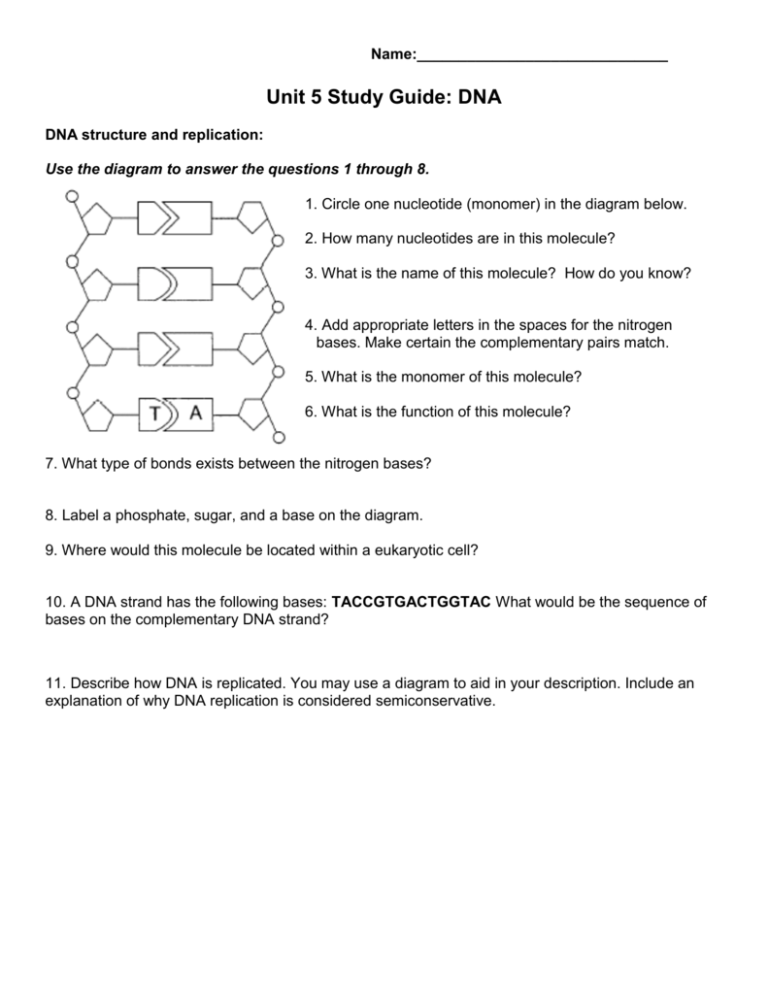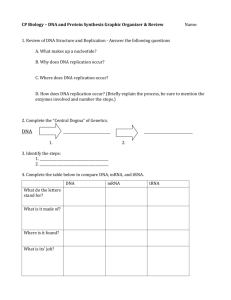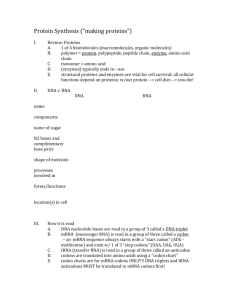DNA Study Guide: Structure, Replication, & Mutations
advertisement

Name:______________________________ Unit 5 Study Guide: DNA DNA structure and replication: Use the diagram to answer the questions 1 through 8. 1. Circle one nucleotide (monomer) in the diagram below. 2. How many nucleotides are in this molecule? 3. What is the name of this molecule? How do you know? 4. Add appropriate letters in the spaces for the nitrogen bases. Make certain the complementary pairs match. 5. What is the monomer of this molecule? 6. What is the function of this molecule? 7. What type of bonds exists between the nitrogen bases? 8. Label a phosphate, sugar, and a base on the diagram. 9. Where would this molecule be located within a eukaryotic cell? 10. A DNA strand has the following bases: TACCGTGACTGGTAC What would be the sequence of bases on the complementary DNA strand? 11. Describe how DNA is replicated. You may use a diagram to aid in your description. Include an explanation of why DNA replication is considered semiconservative. 12. Complete the following chart: Type of Nucleic Acid Official Name Single or Double Stranded Function Locations it can be found in a eukaryotic cell What are its nitrogenous bases? DNA mRNA tRNA rRNA 13. Complete the chart to compare DNA and RNA. Characteristic DNA ONLY double stranded single stranded contains nucleotide - A contains nucleotide - T contains nucleotide - C contains nucleotide - G contains nucleotide - U only in the nucleus of eukaryotes can enter & leave the nucleus of eukaryotes transports amino acids to the ribosome carries the DNA code to the ribosome Transcription/translation: 14. Explain the process of transcription: 15. Where does mRNA take the DNA code after it is transcribed? 16. Examine the chart to the right: 17. What is the mRNA sequence that codes for phenylalanine? 18. What would be the DNA sequence that codes for phenylalanine? RNA ONLY BOTH DNA & RNA 19. Use the chart above & your knowledge to complete the table. DNA Codon mRNA codon tRNA anti-codon Amino Acid phenylalanine AAA GCT UUU 20. What is a codon? Where is it located (mRNA or tRNA)? 21. Explain what occurs during “translation.” 22. In what part of the eukaryotic or prokaryotic cell does translation take place? 23. What is the function of tRNA? 24. What type of molecule results from translation? (give 2 possible names for the resulting molecule) 26. What is an “anti-codon”? 27. Use the following diagram to answer the questions below: A. What is the structure labeled “X”? Give 2 reasons why you know this is true. B. Glycine is what type of molecule? C. Circle and label a tRNA molecule. D. Circle and label an amino acid molecule. E. Draw a box around and label a tRNA anti-codon. F. Draw a box around and label an mRNA codon. 35. Place the following events in the correct order. CORRECT SEQUENCE BY NUMBER CONCEPT DESCRIPTION resulting proteins have a 3-D shape mRNA leaves the nucleus & takes the transcribed code to the ribosome amino acids are linked into polypeptides by peptide bonds each particular protein has a particular function and/or codes for a particular trait mRNA is transcribed from DNA in the nucleus proteins determine an organism’s traits tRNA molecules bring specific amino acids to the ribosome Mutations: 37. List the types of mutations that can occur in DNA coding. 38. Label the following mutations with the correct name. TYPE OF MUTATION EXAMPLE A A A A A A T T T T T T C T C G C C G G G T G A T T T A T G A A A A T A 44. Fill in the blanks suing these words: variability – natural selection - lethal All mutations are not ___________________. In fact, mutations give genetic ________________________ which allows organisms with that mutation to better survive in unfavorable conditions. Mutations help drive the process of ______________________ __________________________. Cell specialization: 45. Do all cells (except sperm and eggs) have the same DNA? 46. How do cells become muscle cells, nerve cells, skin cells, etc.? 48. List 3 specialized plant cells and 3 specialized animal cells. What are their functions(special jobs)?









